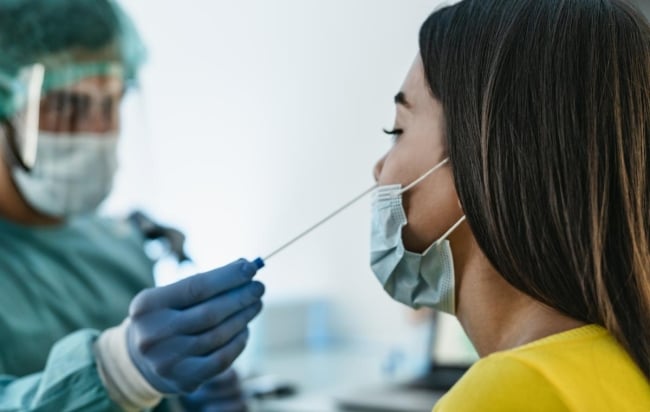You have /5 articles left.
Sign up for a free account or log in.

Colleges are relying on testing and vaccines as they resume classes on campus.
Getty Images
Colleges across the country that are pivoting to remote instruction and delaying the start of the spring semester may have caught the headlines, but they are in the minority. The vast majority of institutions are returning to in-person learning as scheduled.
According to data from the College Crisis Initiative at Davidson College, nearly 90 percent of colleges and universities are welcoming students back to campus. Likewise, 98 percent will start on time, per data from a sample size of 502 institutions.
“There are a good number of institutions bringing students back on schedule,” said Rylie Martin, assistant director of the College Crisis Initiative, or C2i. “Many are maintaining COVID mitigation strategies from the fall semester, which means having indoor masking mandates, requiring either re-entry testing once students get back to campus or testing prior to coming back.”
Martin added that vaccine mandates or incentives to get vaccinated are also common.
Making the Decision
Across the country, different campuses are arriving at different decisions—even within the same system. In the University of North Carolina system, for example, some colleges are pushing the start of the semester back or going temporarily remote while others are forging ahead, including North Carolina A&T University, one of a number of historically Black colleges returning in person.
“Public health experts counsel that, like other colleges and universities, we should expect an increase in Omicron variant infections at North Carolina A&T,” the university announced in a press release. “With that understanding, as well as the belief that students learn best when they can experience the university in person, we are carefully and cautiously moving forward with plans for the Spring 2022 Semester.”
Similarly, in the University of California system, most colleges will see a remote start to the semester, but the University of California, Berkeley, plans to return to in-person classes. Unlike many other UC institutions, which are on a quarterly academic calendar, UC Berkeley follows the semester model, which gives it the advantage of time; classes aren’t scheduled to begin until Jan. 18. (This paragraph has been updated with the correct academic calendars.)
“We anticipate learning from the experiences of other colleges and universities as they return to operations weeks ahead of us,” UC Berkeley spokesperson Janet Gilmore wrote in an email. “And, of course, we continue to follow emerging science and guidance, generally.”
But even some colleges with earlier start dates are returning to in-person classes as scheduled, including the University of Michigan, which welcomed students back to campus this week.
Dr. Preeti Malani, a professor and the chief health officer at Michigan, said that colleges are in a much different place now than when the pandemic first hit the U.S. Vaccines, mitigation strategies and the benefit of hindsight helped drive the university’s decision.
“In March of 2020, medical and public health aspects were the only consideration; other issues—equity issues, learning issues and economic issues—were secondary,” Malani said. “Now we’re two years into this. We’ve learned a lot about how to run a campus during a pandemic. We’ve become creative, innovative and also nimble. We don’t know what next week and the week after are going to look like, but we can monitor very closely; we can continue to communicate.”
Sweet Briar College in Virginia also factored the lessons it learned during the pandemic into its decision to bring students back for in-person classes despite the creeping Omicron variant. President Meredith Woo said three lessons that emerged during the pandemic drove that decision: Sweet Briar’s spaciousness, both indoors and outdoors, allowed students to safely spread out; students demonstrated they were willing to follow safety protocols; and the college proved it was nimble and could pivot quickly.
“Those three lessons gave us confidence that even as the nature of this particular pandemic changes, we could deal with situations as they arise by putting effective mitigation measures in place,” Woo said.
Dawn Stewart, vice president of student affairs and director of athletics at Otterbein University in Ohio, said campuswide vaccine mandates and confidence in ongoing mitigation strategies prompted the school to go ahead with in-person classes despite concerns about COVID-19.
“Our plan has been received in a very positive manner,” Stewart said. “I believe our community expected to return to in-person classes and activities because of the fact that we mandated the vaccine in an attempt to best protect and put our community in the best situation possible. I don’t think there was any surprise that we were returning to in-person classes and activities.”
Additionally, she said an in-person experience is what students want and expect.
“Otterbein is a small campus, and we are very relational; we believe in the interpersonal educational experience. So for a campus like ours, our students thrive on having that small classroom setting, that personal interaction with faculty and staff here on campus,” Stewart said. “If we’re not able to provide those opportunities for connection, certainly our students feel that.”
Mitigation Strategies
As colleges bring students back, they are counting on widespread vaccine mandates and the plans they’ve fine-tuned for nearly two years, which often include masking and social distancing.
Michigan’s Malani, who is also an infectious diseases doctor, said she believes COVID is moving from a pandemic to the endemic stage. While the coronavirus may be here to stay, the severity of the disease isn’t, its impact blunted by vaccines that have decreased the threat of infection.
“COVID is going to be here, it’s going to be in the background, hopefully with milder infections as more of the population gains immunity,” Malani said. “From a practical standpoint, for higher education and for the K-12 space, it means finding ways to do the essential work, which is learning, teaching, research and, in our case, also health care.”
Many campuses are mandating not only coronavirus vaccines but also booster shots.
According to C2i data, more than 28 percent of the colleges in its sample are requiring booster shots for students, and nearly 26 percent are requiring boosters for faculty and staff.
However, Martin noted that colleges in some states are legally prohibited from mandating vaccines. Often, she said, such colleges focus on other mitigation strategies and incentivize students to get vaccinated. C2i data also shows a sharp contrast between public and private institutions in mandating booster shots.
“What we’re seeing from our data is at private institutions, almost half are requiring the booster for students; for public [institutions] only around 12 percent are requiring a booster for students,” Martin said.
Another common mitigation strategy, experts say, is testing students as they arrive on campus.
Blowback to In-Person Instruction
Returning to in-person classes is a decision that has prompted outcry and protest on some campuses, with faculty and staff questioning or directly challenging such strategies.
At the University of Michigan, faculty members vowed to teach online for the semester’s first day of classes in protest. More than 1,000 faculty members signaled their support for this defiance of university plans by signing on to a letter saying they would teach virtually or promising to support those who do.
Across the country members of United Campus Workers Arizona have pushed back on returning to in-person classes by sending letters to the leadership of Arizona State University and the University of Arizona asking that campuses operate remotely through Jan. 28. Additionally, the organization requested that the universities provide free high-quality masks, twice-weekly testing and free rapid coronavirus tests, as well as the implementation of vaccine mandates for students.
While the spring semester is already underway at many colleges, it’s still on the horizon at others. And if there’s any constant in terms of what to expect, said Martin, it’s change. With many colleges yet to detail their plans for spring, she expects a flurry of policy announcements in the coming days as the start of the semester looms. Despite their varying approaches, the end goal, she suggested, is largely the same.
“While we do have delays … I think the goal of institutions is to get back to normal as quickly as possible,” Martin said. “That means, in the first few weeks as students are coming back from break, coming back from different states, trying to contain the virus as much as possible.”







